Entrepreneurship: Venture Analysis and Small Business Management
VerifiedAdded on 2020/10/23
|14
|3313
|300
Report
AI Summary
This report provides a comprehensive analysis of entrepreneurship and small business management, defining different entrepreneurial ventures such as small businesses, scalable start-ups, large companies, and social entrepreneurship. It explores the similarities and differences between these ventures, highlighting their roles in both private and public sectors, and their varying approaches to finance and objectives. The report assesses the significant impact of micro and small businesses on the economy, emphasizing their contributions to job creation, GDP growth, and community development. It also evaluates the characteristics, traits, and skills essential for successful entrepreneurs, reflecting on how entrepreneurial personalities and motivations align with the OCEAN model. Furthermore, the report examines potential hindrances to entrepreneurship related to background and experience, providing a well-rounded view of the entrepreneurial landscape. Desklib offers a wealth of resources, including past papers and solved assignments, for students seeking to further their understanding of these topics.

Entrepreneurship
and
Small Business Management
and
Small Business Management
Paraphrase This Document
Need a fresh take? Get an instant paraphrase of this document with our AI Paraphraser
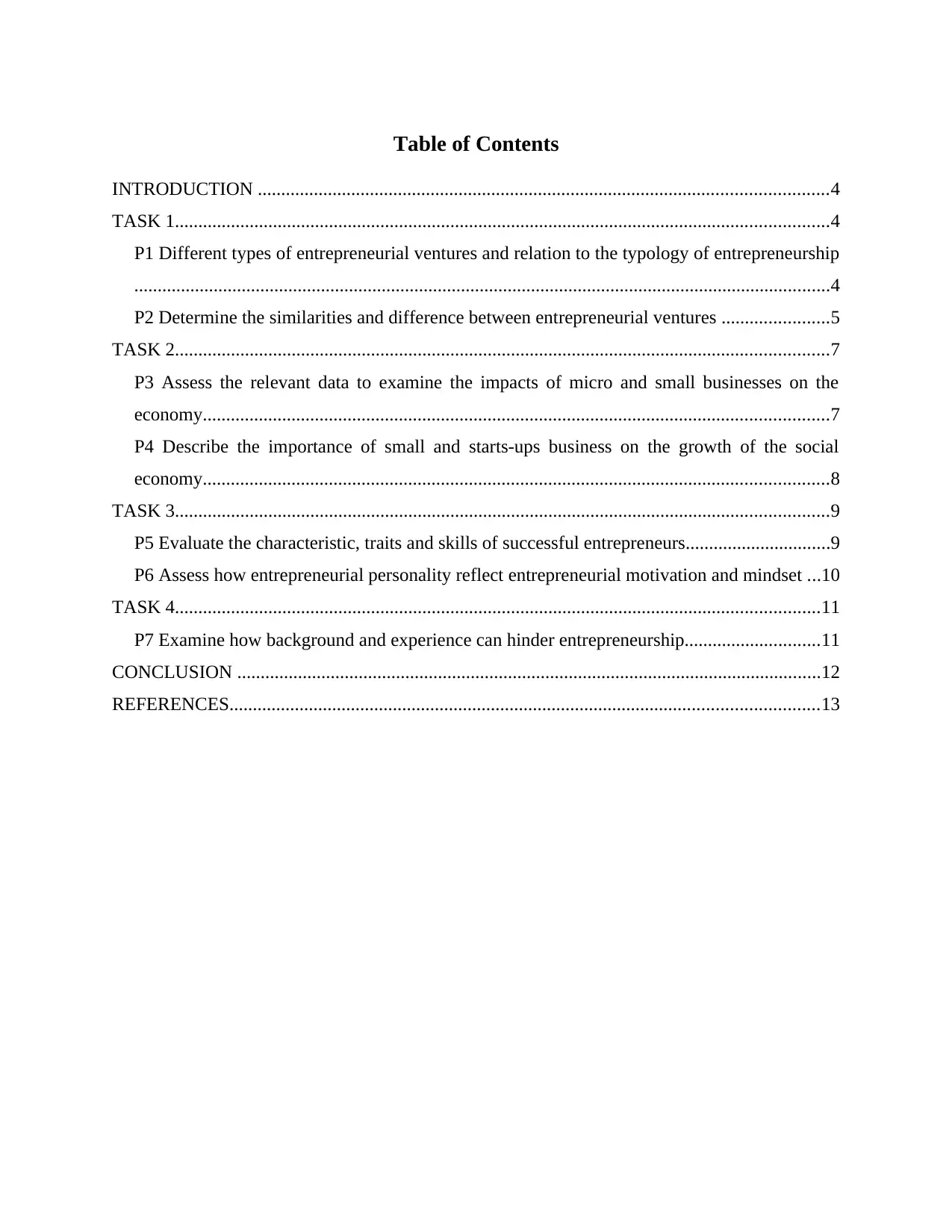
Table of Contents
INTRODUCTION ..........................................................................................................................4
TASK 1............................................................................................................................................4
P1 Different types of entrepreneurial ventures and relation to the typology of entrepreneurship
.....................................................................................................................................................4
P2 Determine the similarities and difference between entrepreneurial ventures .......................5
TASK 2............................................................................................................................................7
P3 Assess the relevant data to examine the impacts of micro and small businesses on the
economy......................................................................................................................................7
P4 Describe the importance of small and starts-ups business on the growth of the social
economy......................................................................................................................................8
TASK 3............................................................................................................................................9
P5 Evaluate the characteristic, traits and skills of successful entrepreneurs...............................9
P6 Assess how entrepreneurial personality reflect entrepreneurial motivation and mindset ...10
TASK 4..........................................................................................................................................11
P7 Examine how background and experience can hinder entrepreneurship.............................11
CONCLUSION .............................................................................................................................12
REFERENCES..............................................................................................................................13
INTRODUCTION ..........................................................................................................................4
TASK 1............................................................................................................................................4
P1 Different types of entrepreneurial ventures and relation to the typology of entrepreneurship
.....................................................................................................................................................4
P2 Determine the similarities and difference between entrepreneurial ventures .......................5
TASK 2............................................................................................................................................7
P3 Assess the relevant data to examine the impacts of micro and small businesses on the
economy......................................................................................................................................7
P4 Describe the importance of small and starts-ups business on the growth of the social
economy......................................................................................................................................8
TASK 3............................................................................................................................................9
P5 Evaluate the characteristic, traits and skills of successful entrepreneurs...............................9
P6 Assess how entrepreneurial personality reflect entrepreneurial motivation and mindset ...10
TASK 4..........................................................................................................................................11
P7 Examine how background and experience can hinder entrepreneurship.............................11
CONCLUSION .............................................................................................................................12
REFERENCES..............................................................................................................................13

Illustration Index
Illustration 1: Economic growth....................................................................................................10
Illustration 1: Economic growth....................................................................................................10
⊘ This is a preview!⊘
Do you want full access?
Subscribe today to unlock all pages.

Trusted by 1+ million students worldwide
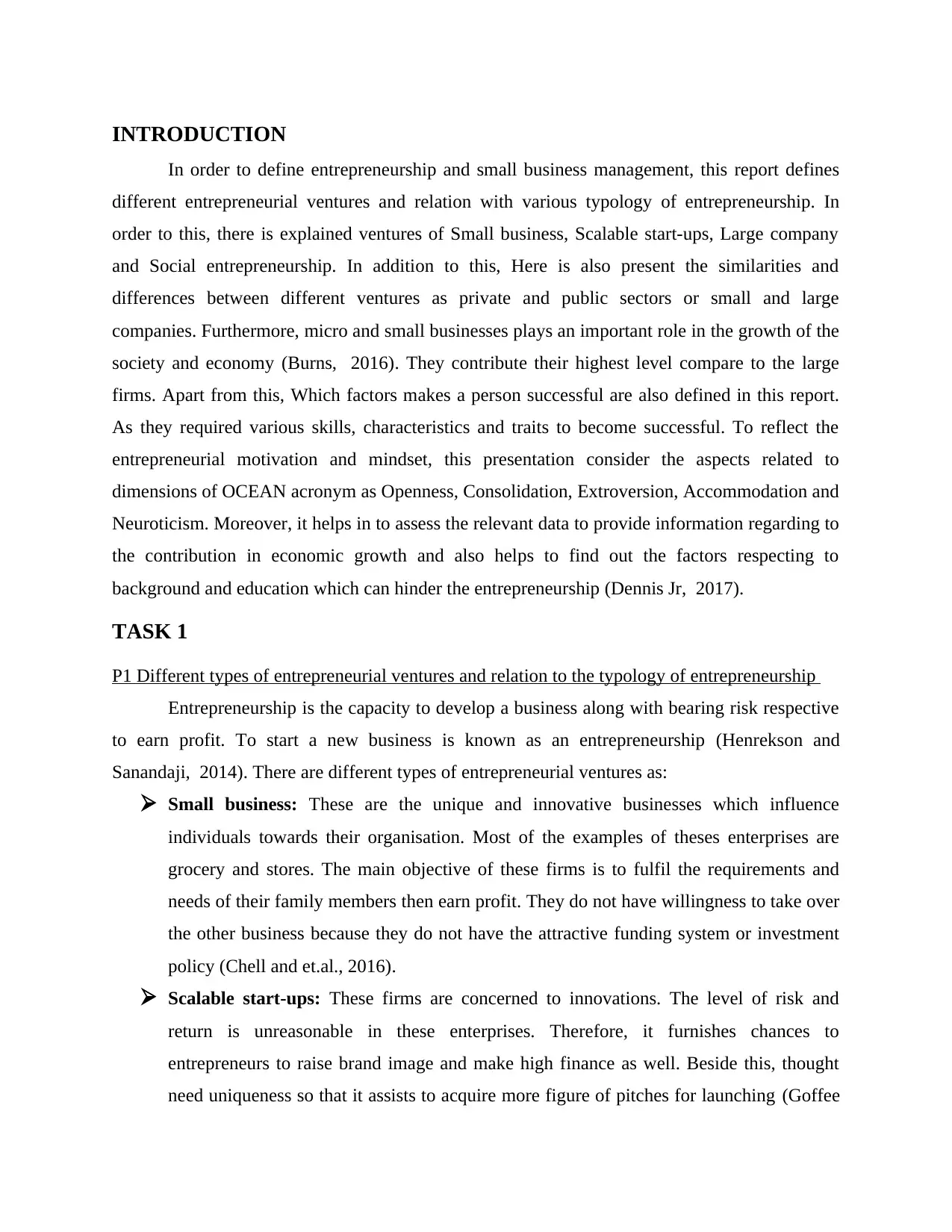
INTRODUCTION
In order to define entrepreneurship and small business management, this report defines
different entrepreneurial ventures and relation with various typology of entrepreneurship. In
order to this, there is explained ventures of Small business, Scalable start-ups, Large company
and Social entrepreneurship. In addition to this, Here is also present the similarities and
differences between different ventures as private and public sectors or small and large
companies. Furthermore, micro and small businesses plays an important role in the growth of the
society and economy (Burns, 2016). They contribute their highest level compare to the large
firms. Apart from this, Which factors makes a person successful are also defined in this report.
As they required various skills, characteristics and traits to become successful. To reflect the
entrepreneurial motivation and mindset, this presentation consider the aspects related to
dimensions of OCEAN acronym as Openness, Consolidation, Extroversion, Accommodation and
Neuroticism. Moreover, it helps in to assess the relevant data to provide information regarding to
the contribution in economic growth and also helps to find out the factors respecting to
background and education which can hinder the entrepreneurship (Dennis Jr, 2017).
TASK 1
P1 Different types of entrepreneurial ventures and relation to the typology of entrepreneurship
Entrepreneurship is the capacity to develop a business along with bearing risk respective
to earn profit. To start a new business is known as an entrepreneurship (Henrekson and
Sanandaji, 2014). There are different types of entrepreneurial ventures as:
Small business: These are the unique and innovative businesses which influence
individuals towards their organisation. Most of the examples of theses enterprises are
grocery and stores. The main objective of these firms is to fulfil the requirements and
needs of their family members then earn profit. They do not have willingness to take over
the other business because they do not have the attractive funding system or investment
policy (Chell and et.al., 2016).
Scalable start-ups: These firms are concerned to innovations. The level of risk and
return is unreasonable in these enterprises. Therefore, it furnishes chances to
entrepreneurs to raise brand image and make high finance as well. Beside this, thought
need uniqueness so that it assists to acquire more figure of pitches for launching (Goffee
In order to define entrepreneurship and small business management, this report defines
different entrepreneurial ventures and relation with various typology of entrepreneurship. In
order to this, there is explained ventures of Small business, Scalable start-ups, Large company
and Social entrepreneurship. In addition to this, Here is also present the similarities and
differences between different ventures as private and public sectors or small and large
companies. Furthermore, micro and small businesses plays an important role in the growth of the
society and economy (Burns, 2016). They contribute their highest level compare to the large
firms. Apart from this, Which factors makes a person successful are also defined in this report.
As they required various skills, characteristics and traits to become successful. To reflect the
entrepreneurial motivation and mindset, this presentation consider the aspects related to
dimensions of OCEAN acronym as Openness, Consolidation, Extroversion, Accommodation and
Neuroticism. Moreover, it helps in to assess the relevant data to provide information regarding to
the contribution in economic growth and also helps to find out the factors respecting to
background and education which can hinder the entrepreneurship (Dennis Jr, 2017).
TASK 1
P1 Different types of entrepreneurial ventures and relation to the typology of entrepreneurship
Entrepreneurship is the capacity to develop a business along with bearing risk respective
to earn profit. To start a new business is known as an entrepreneurship (Henrekson and
Sanandaji, 2014). There are different types of entrepreneurial ventures as:
Small business: These are the unique and innovative businesses which influence
individuals towards their organisation. Most of the examples of theses enterprises are
grocery and stores. The main objective of these firms is to fulfil the requirements and
needs of their family members then earn profit. They do not have willingness to take over
the other business because they do not have the attractive funding system or investment
policy (Chell and et.al., 2016).
Scalable start-ups: These firms are concerned to innovations. The level of risk and
return is unreasonable in these enterprises. Therefore, it furnishes chances to
entrepreneurs to raise brand image and make high finance as well. Beside this, thought
need uniqueness so that it assists to acquire more figure of pitches for launching (Goffee
Paraphrase This Document
Need a fresh take? Get an instant paraphrase of this document with our AI Paraphraser

and Scase, 2015). This venture possesses typology to render innovations in respective
commodities and services.
Large company: These enterprises are wide and broad. The requirement of theses
enterprises is to develop new and innovative products and sold it into new markets. They
have strong strategies to attract investors to invest the money in their business (Goffee
and Scase, 2015).
Social entrepreneurship: The main goal of these enterprises is to provide social
facilities rather than earn profit. They measure their success in terms of improvement of
the society and economy (Hatten, 2015). The focus of these firms is on issues and
complexities regarding to social and commercial factors. In this way, typology has been
carried in the effectual kind in club which serve in effective and efficient manner. These
organisations have various advantages and drawbacks as well. Benefits as economic
expansion, development of society, economic growth and technological advancement.
But these firms also have to face antithetical complexities and problems regarding to
competitive market (Henrekson and Sanandaji, 2014).
Lifestyle entrepreneurship: They centring on upcoming improvement programs that
held in the structure to acquire and deal risk capacity.
P2 Determine the similarities and difference between entrepreneurial ventures
Aims and objectives
In order to define the similarities and dissimilarities between the entrepreneurial ventures,
It has been assesses that the main objective of the small business is to fulfil the needs of their
family members while to earn profit is the aim of large enterprises. The focus point of the SMEs
is to meet the requirements of the customers. However, large companies have to create new
products with innovative ideas and required to sold it into new market place. It refers to new
geographical location (Keating, 2016).
Sources of finance
To fulfil the requirements of financial aspects, there are different sources of funding
system for both of the enterprises. As small enterprises can gather money from their friends and
family members. They do not have capability to attract angel investors or financial committees.
commodities and services.
Large company: These enterprises are wide and broad. The requirement of theses
enterprises is to develop new and innovative products and sold it into new markets. They
have strong strategies to attract investors to invest the money in their business (Goffee
and Scase, 2015).
Social entrepreneurship: The main goal of these enterprises is to provide social
facilities rather than earn profit. They measure their success in terms of improvement of
the society and economy (Hatten, 2015). The focus of these firms is on issues and
complexities regarding to social and commercial factors. In this way, typology has been
carried in the effectual kind in club which serve in effective and efficient manner. These
organisations have various advantages and drawbacks as well. Benefits as economic
expansion, development of society, economic growth and technological advancement.
But these firms also have to face antithetical complexities and problems regarding to
competitive market (Henrekson and Sanandaji, 2014).
Lifestyle entrepreneurship: They centring on upcoming improvement programs that
held in the structure to acquire and deal risk capacity.
P2 Determine the similarities and difference between entrepreneurial ventures
Aims and objectives
In order to define the similarities and dissimilarities between the entrepreneurial ventures,
It has been assesses that the main objective of the small business is to fulfil the needs of their
family members while to earn profit is the aim of large enterprises. The focus point of the SMEs
is to meet the requirements of the customers. However, large companies have to create new
products with innovative ideas and required to sold it into new market place. It refers to new
geographical location (Keating, 2016).
Sources of finance
To fulfil the requirements of financial aspects, there are different sources of funding
system for both of the enterprises. As small enterprises can gather money from their friends and
family members. They do not have capability to attract angel investors or financial committees.
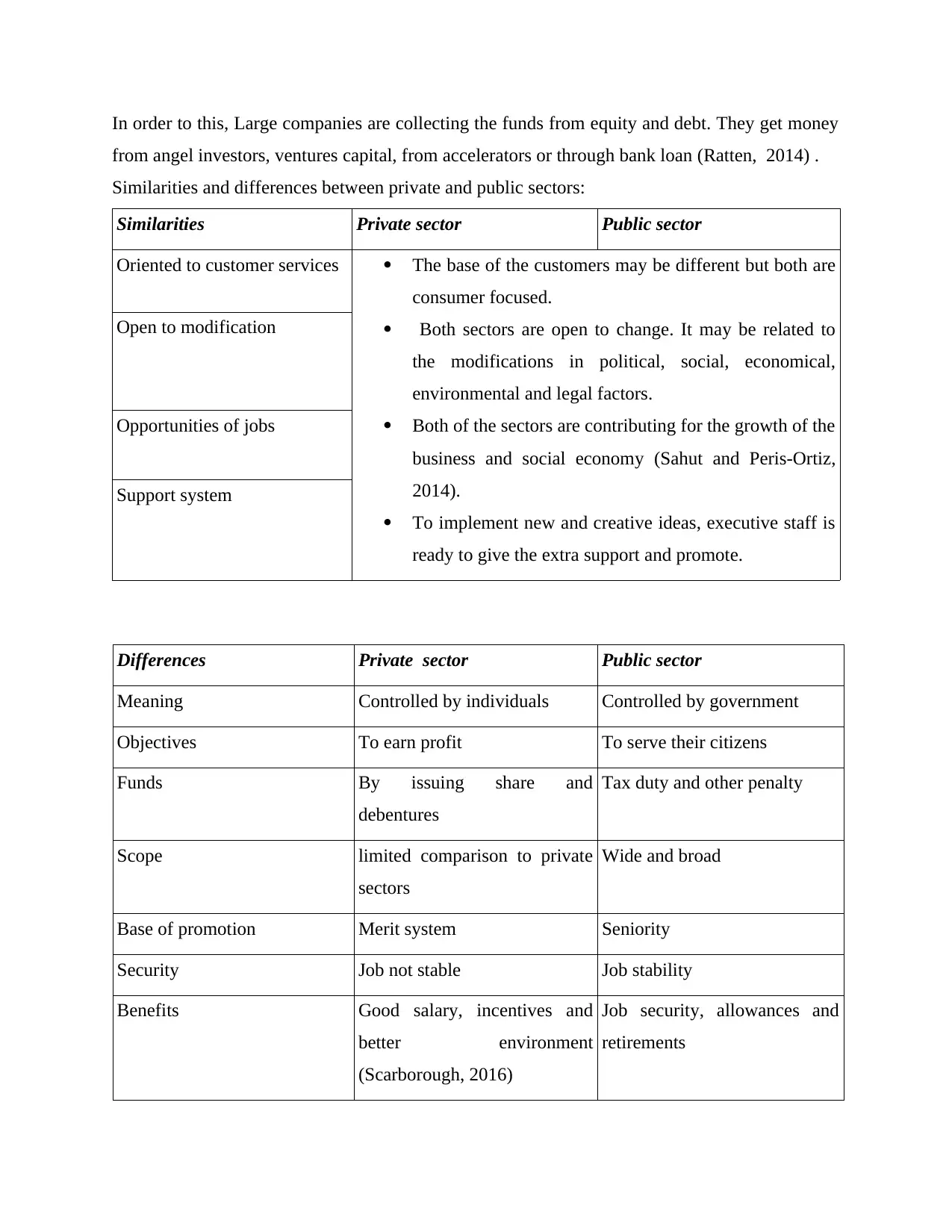
In order to this, Large companies are collecting the funds from equity and debt. They get money
from angel investors, ventures capital, from accelerators or through bank loan (Ratten, 2014) .
Similarities and differences between private and public sectors:
Similarities Private sector Public sector
Oriented to customer services The base of the customers may be different but both are
consumer focused.
Both sectors are open to change. It may be related to
the modifications in political, social, economical,
environmental and legal factors.
Both of the sectors are contributing for the growth of the
business and social economy (Sahut and Peris-Ortiz,
2014).
To implement new and creative ideas, executive staff is
ready to give the extra support and promote.
Open to modification
Opportunities of jobs
Support system
Differences Private sector Public sector
Meaning Controlled by individuals Controlled by government
Objectives To earn profit To serve their citizens
Funds By issuing share and
debentures
Tax duty and other penalty
Scope limited comparison to private
sectors
Wide and broad
Base of promotion Merit system Seniority
Security Job not stable Job stability
Benefits Good salary, incentives and
better environment
(Scarborough, 2016)
Job security, allowances and
retirements
from angel investors, ventures capital, from accelerators or through bank loan (Ratten, 2014) .
Similarities and differences between private and public sectors:
Similarities Private sector Public sector
Oriented to customer services The base of the customers may be different but both are
consumer focused.
Both sectors are open to change. It may be related to
the modifications in political, social, economical,
environmental and legal factors.
Both of the sectors are contributing for the growth of the
business and social economy (Sahut and Peris-Ortiz,
2014).
To implement new and creative ideas, executive staff is
ready to give the extra support and promote.
Open to modification
Opportunities of jobs
Support system
Differences Private sector Public sector
Meaning Controlled by individuals Controlled by government
Objectives To earn profit To serve their citizens
Funds By issuing share and
debentures
Tax duty and other penalty
Scope limited comparison to private
sectors
Wide and broad
Base of promotion Merit system Seniority
Security Job not stable Job stability
Benefits Good salary, incentives and
better environment
(Scarborough, 2016)
Job security, allowances and
retirements
⊘ This is a preview!⊘
Do you want full access?
Subscribe today to unlock all pages.

Trusted by 1+ million students worldwide

Forms Sole properties and Franchise Corporations and departmental
undertakings
Execution Related to return on
investment
Related to Reference points
and multiple signals (Spence,
2016).
TASK 2
P3 Assess the relevant data to examine the impacts of micro and small businesses on the
economy
Contribution through educational qualification: These enterprises are hiring
individuals from different categories of ages. The higher number of participating by
matured people who are the main and essential factor of the growth of the economy
(Burns, 2016). It can be interpret by the following table that what are the % of different
ages in the small businesses:
Table 1 interpret the distribution by age which are participating in small businesses
Educational qualification
Age Frequency %
18-25 300 42.85
25-50 310 44.28
50- above 90 12.85
Total 700 100
It can be seen from the above table that higher number of people are involved in small businesses
as there are 44.28% of the person are from 25-50 years age. It means matured people are
working in these types of businesses mostly. Economic impact: In order to determine the economic impacts of small businesses, It
can be assessed through the increased level of opportunities of job created by these
enterprises. They mostly hire local people and also operate their business in rural areas
undertakings
Execution Related to return on
investment
Related to Reference points
and multiple signals (Spence,
2016).
TASK 2
P3 Assess the relevant data to examine the impacts of micro and small businesses on the
economy
Contribution through educational qualification: These enterprises are hiring
individuals from different categories of ages. The higher number of participating by
matured people who are the main and essential factor of the growth of the economy
(Burns, 2016). It can be interpret by the following table that what are the % of different
ages in the small businesses:
Table 1 interpret the distribution by age which are participating in small businesses
Educational qualification
Age Frequency %
18-25 300 42.85
25-50 310 44.28
50- above 90 12.85
Total 700 100
It can be seen from the above table that higher number of people are involved in small businesses
as there are 44.28% of the person are from 25-50 years age. It means matured people are
working in these types of businesses mostly. Economic impact: In order to determine the economic impacts of small businesses, It
can be assessed through the increased level of opportunities of job created by these
enterprises. They mostly hire local people and also operate their business in rural areas
Paraphrase This Document
Need a fresh take? Get an instant paraphrase of this document with our AI Paraphraser
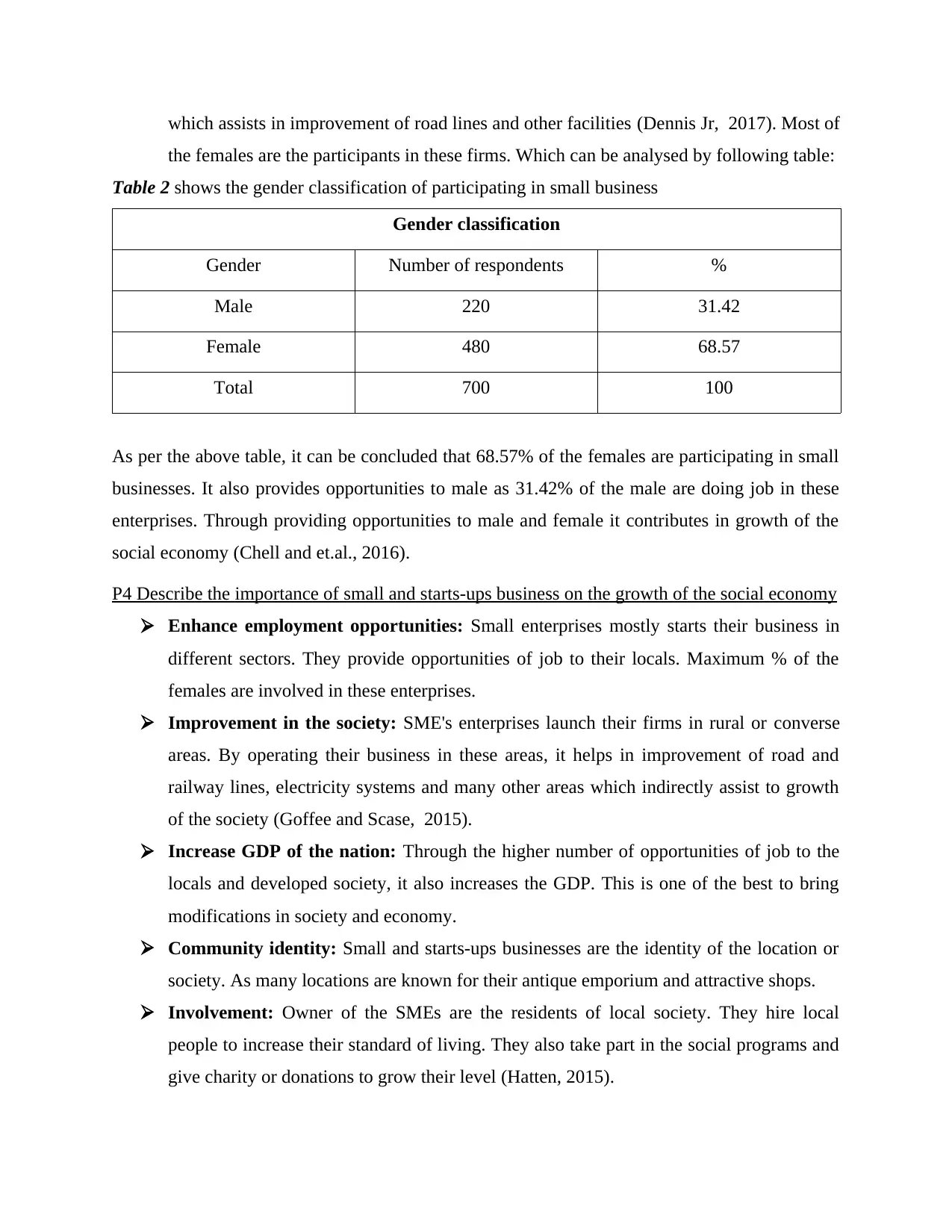
which assists in improvement of road lines and other facilities (Dennis Jr, 2017). Most of
the females are the participants in these firms. Which can be analysed by following table:
Table 2 shows the gender classification of participating in small business
Gender classification
Gender Number of respondents %
Male 220 31.42
Female 480 68.57
Total 700 100
As per the above table, it can be concluded that 68.57% of the females are participating in small
businesses. It also provides opportunities to male as 31.42% of the male are doing job in these
enterprises. Through providing opportunities to male and female it contributes in growth of the
social economy (Chell and et.al., 2016).
P4 Describe the importance of small and starts-ups business on the growth of the social economy
Enhance employment opportunities: Small enterprises mostly starts their business in
different sectors. They provide opportunities of job to their locals. Maximum % of the
females are involved in these enterprises.
Improvement in the society: SME's enterprises launch their firms in rural or converse
areas. By operating their business in these areas, it helps in improvement of road and
railway lines, electricity systems and many other areas which indirectly assist to growth
of the society (Goffee and Scase, 2015).
Increase GDP of the nation: Through the higher number of opportunities of job to the
locals and developed society, it also increases the GDP. This is one of the best to bring
modifications in society and economy.
Community identity: Small and starts-ups businesses are the identity of the location or
society. As many locations are known for their antique emporium and attractive shops.
Involvement: Owner of the SMEs are the residents of local society. They hire local
people to increase their standard of living. They also take part in the social programs and
give charity or donations to grow their level (Hatten, 2015).
the females are the participants in these firms. Which can be analysed by following table:
Table 2 shows the gender classification of participating in small business
Gender classification
Gender Number of respondents %
Male 220 31.42
Female 480 68.57
Total 700 100
As per the above table, it can be concluded that 68.57% of the females are participating in small
businesses. It also provides opportunities to male as 31.42% of the male are doing job in these
enterprises. Through providing opportunities to male and female it contributes in growth of the
social economy (Chell and et.al., 2016).
P4 Describe the importance of small and starts-ups business on the growth of the social economy
Enhance employment opportunities: Small enterprises mostly starts their business in
different sectors. They provide opportunities of job to their locals. Maximum % of the
females are involved in these enterprises.
Improvement in the society: SME's enterprises launch their firms in rural or converse
areas. By operating their business in these areas, it helps in improvement of road and
railway lines, electricity systems and many other areas which indirectly assist to growth
of the society (Goffee and Scase, 2015).
Increase GDP of the nation: Through the higher number of opportunities of job to the
locals and developed society, it also increases the GDP. This is one of the best to bring
modifications in society and economy.
Community identity: Small and starts-ups businesses are the identity of the location or
society. As many locations are known for their antique emporium and attractive shops.
Involvement: Owner of the SMEs are the residents of local society. They hire local
people to increase their standard of living. They also take part in the social programs and
give charity or donations to grow their level (Hatten, 2015).
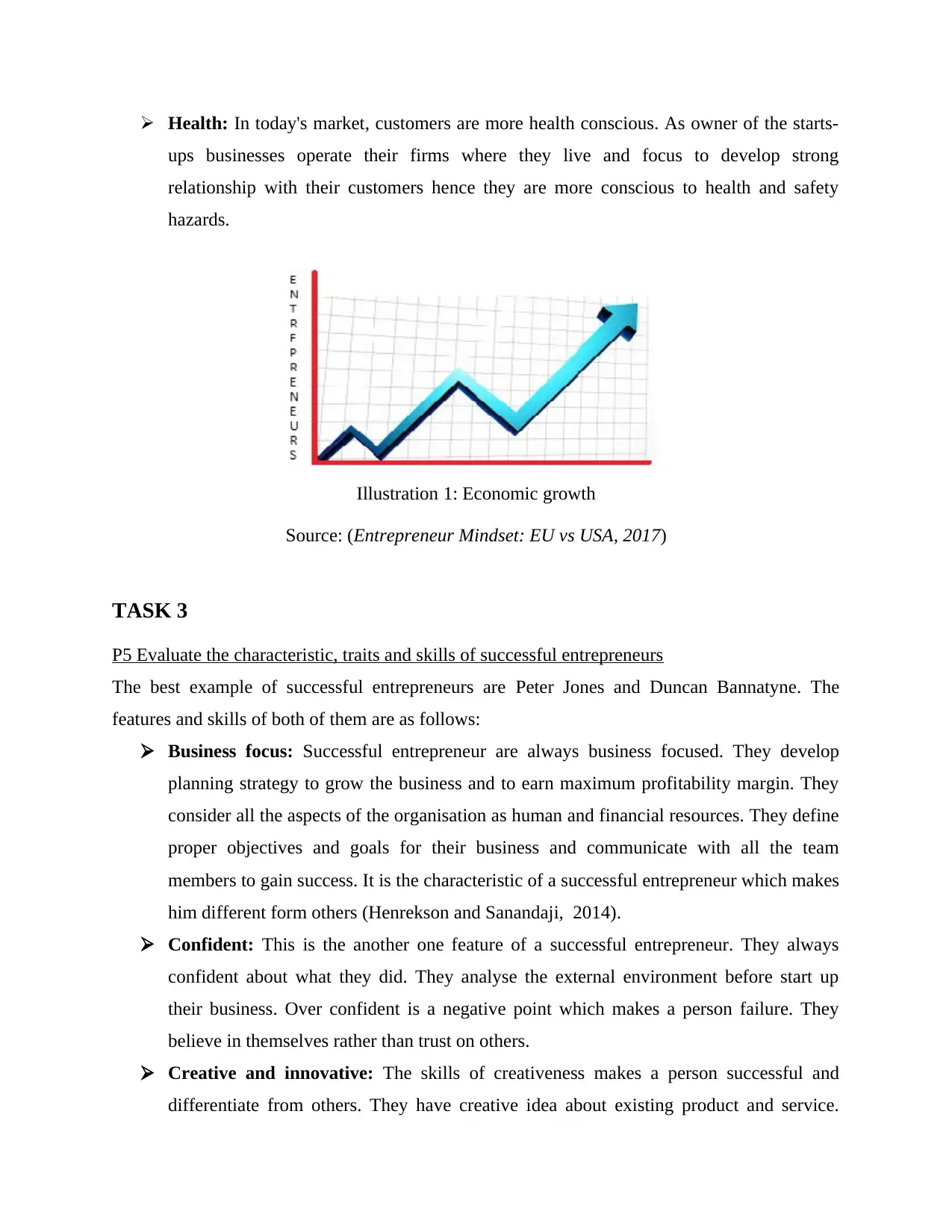
Health: In today's market, customers are more health conscious. As owner of the starts-
ups businesses operate their firms where they live and focus to develop strong
relationship with their customers hence they are more conscious to health and safety
hazards.
TASK 3
P5 Evaluate the characteristic, traits and skills of successful entrepreneurs
The best example of successful entrepreneurs are Peter Jones and Duncan Bannatyne. The
features and skills of both of them are as follows:
Business focus: Successful entrepreneur are always business focused. They develop
planning strategy to grow the business and to earn maximum profitability margin. They
consider all the aspects of the organisation as human and financial resources. They define
proper objectives and goals for their business and communicate with all the team
members to gain success. It is the characteristic of a successful entrepreneur which makes
him different form others (Henrekson and Sanandaji, 2014).
Confident: This is the another one feature of a successful entrepreneur. They always
confident about what they did. They analyse the external environment before start up
their business. Over confident is a negative point which makes a person failure. They
believe in themselves rather than trust on others.
Creative and innovative: The skills of creativeness makes a person successful and
differentiate from others. They have creative idea about existing product and service.
Illustration 1: Economic growth
Source: (Entrepreneur Mindset: EU vs USA, 2017)
ups businesses operate their firms where they live and focus to develop strong
relationship with their customers hence they are more conscious to health and safety
hazards.
TASK 3
P5 Evaluate the characteristic, traits and skills of successful entrepreneurs
The best example of successful entrepreneurs are Peter Jones and Duncan Bannatyne. The
features and skills of both of them are as follows:
Business focus: Successful entrepreneur are always business focused. They develop
planning strategy to grow the business and to earn maximum profitability margin. They
consider all the aspects of the organisation as human and financial resources. They define
proper objectives and goals for their business and communicate with all the team
members to gain success. It is the characteristic of a successful entrepreneur which makes
him different form others (Henrekson and Sanandaji, 2014).
Confident: This is the another one feature of a successful entrepreneur. They always
confident about what they did. They analyse the external environment before start up
their business. Over confident is a negative point which makes a person failure. They
believe in themselves rather than trust on others.
Creative and innovative: The skills of creativeness makes a person successful and
differentiate from others. They have creative idea about existing product and service.
Illustration 1: Economic growth
Source: (Entrepreneur Mindset: EU vs USA, 2017)
⊘ This is a preview!⊘
Do you want full access?
Subscribe today to unlock all pages.

Trusted by 1+ million students worldwide
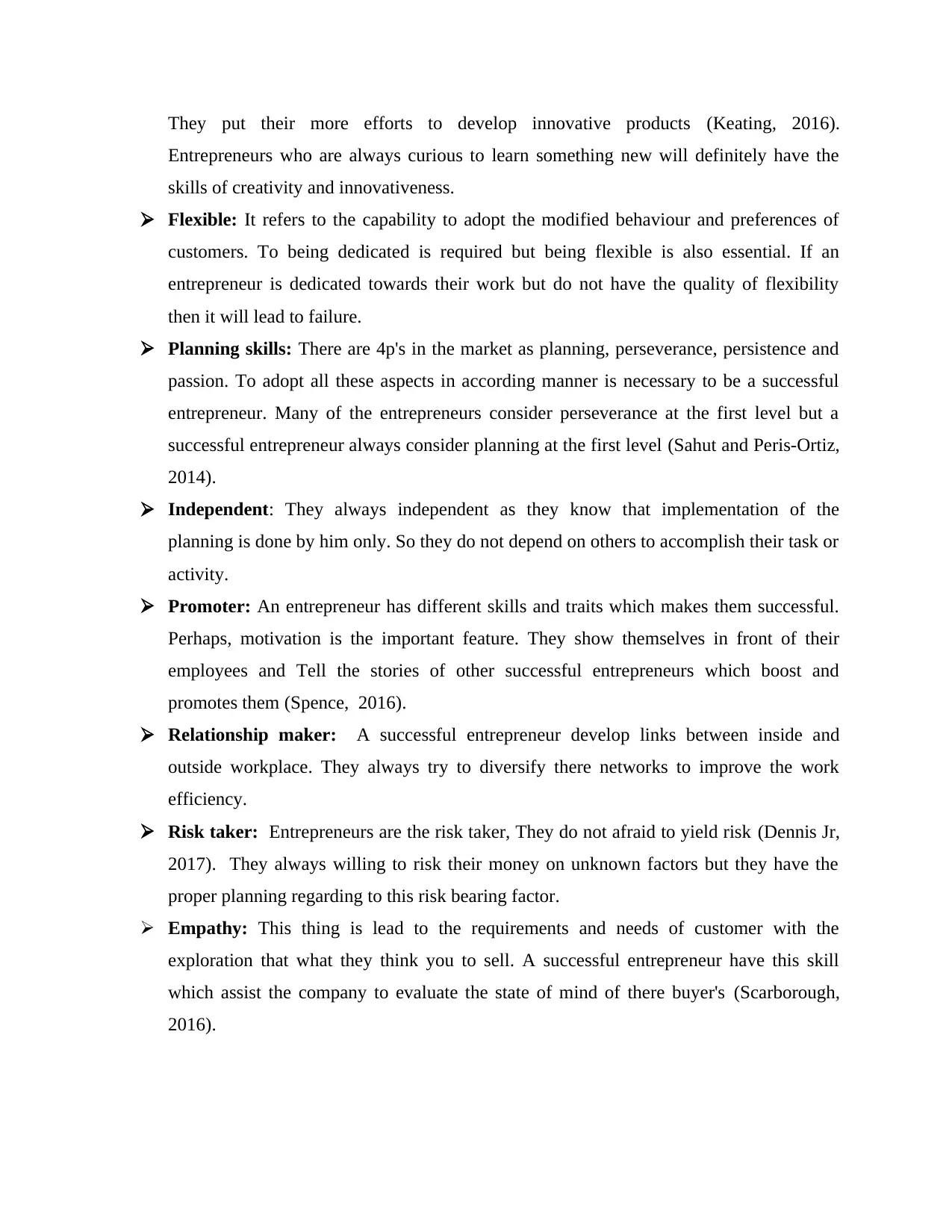
They put their more efforts to develop innovative products (Keating, 2016).
Entrepreneurs who are always curious to learn something new will definitely have the
skills of creativity and innovativeness.
Flexible: It refers to the capability to adopt the modified behaviour and preferences of
customers. To being dedicated is required but being flexible is also essential. If an
entrepreneur is dedicated towards their work but do not have the quality of flexibility
then it will lead to failure.
Planning skills: There are 4p's in the market as planning, perseverance, persistence and
passion. To adopt all these aspects in according manner is necessary to be a successful
entrepreneur. Many of the entrepreneurs consider perseverance at the first level but a
successful entrepreneur always consider planning at the first level (Sahut and Peris-Ortiz,
2014).
Independent: They always independent as they know that implementation of the
planning is done by him only. So they do not depend on others to accomplish their task or
activity.
Promoter: An entrepreneur has different skills and traits which makes them successful.
Perhaps, motivation is the important feature. They show themselves in front of their
employees and Tell the stories of other successful entrepreneurs which boost and
promotes them (Spence, 2016).
Relationship maker: A successful entrepreneur develop links between inside and
outside workplace. They always try to diversify there networks to improve the work
efficiency.
Risk taker: Entrepreneurs are the risk taker, They do not afraid to yield risk (Dennis Jr,
2017). They always willing to risk their money on unknown factors but they have the
proper planning regarding to this risk bearing factor.
Empathy: This thing is lead to the requirements and needs of customer with the
exploration that what they think you to sell. A successful entrepreneur have this skill
which assist the company to evaluate the state of mind of there buyer's (Scarborough,
2016).
Entrepreneurs who are always curious to learn something new will definitely have the
skills of creativity and innovativeness.
Flexible: It refers to the capability to adopt the modified behaviour and preferences of
customers. To being dedicated is required but being flexible is also essential. If an
entrepreneur is dedicated towards their work but do not have the quality of flexibility
then it will lead to failure.
Planning skills: There are 4p's in the market as planning, perseverance, persistence and
passion. To adopt all these aspects in according manner is necessary to be a successful
entrepreneur. Many of the entrepreneurs consider perseverance at the first level but a
successful entrepreneur always consider planning at the first level (Sahut and Peris-Ortiz,
2014).
Independent: They always independent as they know that implementation of the
planning is done by him only. So they do not depend on others to accomplish their task or
activity.
Promoter: An entrepreneur has different skills and traits which makes them successful.
Perhaps, motivation is the important feature. They show themselves in front of their
employees and Tell the stories of other successful entrepreneurs which boost and
promotes them (Spence, 2016).
Relationship maker: A successful entrepreneur develop links between inside and
outside workplace. They always try to diversify there networks to improve the work
efficiency.
Risk taker: Entrepreneurs are the risk taker, They do not afraid to yield risk (Dennis Jr,
2017). They always willing to risk their money on unknown factors but they have the
proper planning regarding to this risk bearing factor.
Empathy: This thing is lead to the requirements and needs of customer with the
exploration that what they think you to sell. A successful entrepreneur have this skill
which assist the company to evaluate the state of mind of there buyer's (Scarborough,
2016).
Paraphrase This Document
Need a fresh take? Get an instant paraphrase of this document with our AI Paraphraser

P6 Assess how entrepreneurial personality reflect entrepreneurial motivation and mindset
Personality of an individual plays a crucial role which reflect the motivation and mind set
of the entrepreneur. It is not identical to the aspects of skills and traits. It can be characterised by
their lifestyle and living status (Chell and et.al., 2016). In addition to this, It considers OCEAN
acronym which can explain the personality factor in effective manner.
Openness: It reflects the level of intellectual creativity which a person has. It is the level
of self actualisation where an individual is independent.
Conscientiousness: Ability which shows self discipline and dutiful rather than
spontaneous behaviour.
Extroversion: It refers to the positive attitude, assertiveness, talkativeness and energy
attributes. People who are with the features of extroversion tend to be more dominant in
social aspects (Henrekson and Sanandaji, 2014).
Agreeableness: Ability to more cooperative and coordinative rather than suspicious
towards others.
Neuroticism: It is the degree of emotional stability which may be high or low. Both are
connected with different aspects.
TASK 4
P7 Examine how background and experience can hinder entrepreneurship
Education is the main factor which can foster the entrepreneurship. A person's experience
and knowledge level can impact the performance level. Family background includes size and
living status of their family members. In this aspect, This report defines the background and
experience of successful entrepreneurs as Zukerberg. He possesses strong background which
shows capabilities and skills level to foster effective past background. He has support by their
family members (Sahut and Peris-Ortiz, 2014). He was co-founder of Facebook application
which used by the people to interact with everyone within the world. He got this idea by his
father who faces different difficulties at global level. Zukerberg also faces different risk factor to
launch the application but this idea was innovative and creative which makes him a successful
entrepreneur in the world.
Apart from this, education is the factor which gives the knowledge about the internal and
external factor of the environment. It is essential to have knowledge about deal with the daily
Personality of an individual plays a crucial role which reflect the motivation and mind set
of the entrepreneur. It is not identical to the aspects of skills and traits. It can be characterised by
their lifestyle and living status (Chell and et.al., 2016). In addition to this, It considers OCEAN
acronym which can explain the personality factor in effective manner.
Openness: It reflects the level of intellectual creativity which a person has. It is the level
of self actualisation where an individual is independent.
Conscientiousness: Ability which shows self discipline and dutiful rather than
spontaneous behaviour.
Extroversion: It refers to the positive attitude, assertiveness, talkativeness and energy
attributes. People who are with the features of extroversion tend to be more dominant in
social aspects (Henrekson and Sanandaji, 2014).
Agreeableness: Ability to more cooperative and coordinative rather than suspicious
towards others.
Neuroticism: It is the degree of emotional stability which may be high or low. Both are
connected with different aspects.
TASK 4
P7 Examine how background and experience can hinder entrepreneurship
Education is the main factor which can foster the entrepreneurship. A person's experience
and knowledge level can impact the performance level. Family background includes size and
living status of their family members. In this aspect, This report defines the background and
experience of successful entrepreneurs as Zukerberg. He possesses strong background which
shows capabilities and skills level to foster effective past background. He has support by their
family members (Sahut and Peris-Ortiz, 2014). He was co-founder of Facebook application
which used by the people to interact with everyone within the world. He got this idea by his
father who faces different difficulties at global level. Zukerberg also faces different risk factor to
launch the application but this idea was innovative and creative which makes him a successful
entrepreneur in the world.
Apart from this, education is the factor which gives the knowledge about the internal and
external factor of the environment. It is essential to have knowledge about deal with the daily

activities. If an individual have great level of knowledge and experience then he will definitely
become success. Family backgrounds consider size, living status, and condition of family
members (Dennis Jr, 2017).
CONCLUSION
From the above report it can be concluded that small businesses plays an important role
in the growth of the economy. In this aspect, present report summarized different ventures as
small, large, lifestyle, scalable starts-ups and social. Private and public both sectors have various
similarities and differences which can be understand by this presented report. Moreover,
Background and education level plays an important role to hinder the entrepreneurship is also
explained in this report which define the importance of these factors. What are the main qualities
and features which makes a person become successful entrepreneur is also explained in broad
manner. These factors also modified the person's mindset and motivate them. Furthermore, by
assessing the statistic data, a government will get to know that how importance of small
businesses in growth of the economy.
become success. Family backgrounds consider size, living status, and condition of family
members (Dennis Jr, 2017).
CONCLUSION
From the above report it can be concluded that small businesses plays an important role
in the growth of the economy. In this aspect, present report summarized different ventures as
small, large, lifestyle, scalable starts-ups and social. Private and public both sectors have various
similarities and differences which can be understand by this presented report. Moreover,
Background and education level plays an important role to hinder the entrepreneurship is also
explained in this report which define the importance of these factors. What are the main qualities
and features which makes a person become successful entrepreneur is also explained in broad
manner. These factors also modified the person's mindset and motivate them. Furthermore, by
assessing the statistic data, a government will get to know that how importance of small
businesses in growth of the economy.
⊘ This is a preview!⊘
Do you want full access?
Subscribe today to unlock all pages.

Trusted by 1+ million students worldwide
1 out of 14
Related Documents
Your All-in-One AI-Powered Toolkit for Academic Success.
+13062052269
info@desklib.com
Available 24*7 on WhatsApp / Email
![[object Object]](/_next/static/media/star-bottom.7253800d.svg)
Unlock your academic potential
Copyright © 2020–2025 A2Z Services. All Rights Reserved. Developed and managed by ZUCOL.





